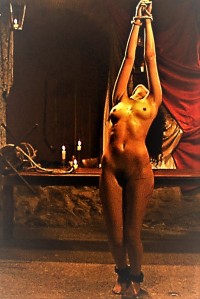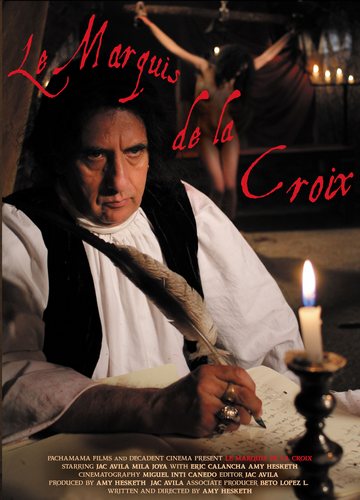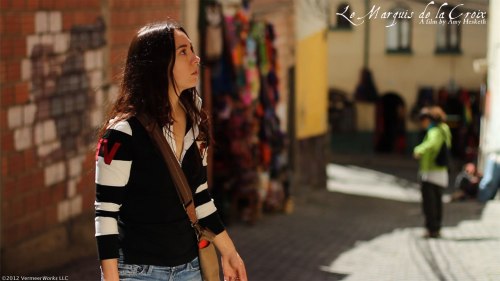Le Marquis, Part One: The Museum
by Rich Moreland, April 2017
Le Marquis de la Croix is a film by Amy Hesketh that features Jac Avila and Mila Joya. It is available for download or on DVD from Vermeerworks.
This is the first of a five-part series on the film and combines a review with commentary from Amy and Jac. The final post is exclusive to Mila Joya, the star of the film.
Le Marquis is another provocative work from the collaboration of Amy and Jac. I highly recommend it.
All photos are courtesy of Pachamama Films.
* * *
The Story
The wealthy marquis, sentenced to his prison confines (luxurious as they are), writes lurid accounts of his sexual imaginations. Fortunately for his perverse addictions, an occasional condemned female criminal is brought to him for a price.
Such is the case with Zynga, a gypsy girl sentenced to death, as the marquis tells us, for “three crimes: murder, theft, and arson” (borrowed incidentally from the Marquis de Sade’s 1791 novel, Justine).
 The film explores the tortures Zynga endures and her eventual demise. The story is presented as a narration extracted from the marquis’ writings in his cell. As he completes one torment and plans the next, the aristocrat returns to his desk to record his thoughts and lets the viewer into his mind via voice over.
The film explores the tortures Zynga endures and her eventual demise. The story is presented as a narration extracted from the marquis’ writings in his cell. As he completes one torment and plans the next, the aristocrat returns to his desk to record his thoughts and lets the viewer into his mind via voice over.
The bound and naked Zynga is the consistent background image and the main motif throughout the film.
Strikingly Innovation
Le Marquis de la Croix is a literary fantasy that operates on different levels. On the surface, it has definite appeal to the BDSM community. Heavily sadomasochistic, the whippings and rack scenes are about as exciting as a bondage film gets. It is realism personified.
The film does, however, offer more. There is an engaging political and religious message that is as appropriate today as it was in Sade’s time, the 18th century setting of the narrative.
Told with a modern flavor, the story also hints at the erotic fascinations of a modern tourist who seeks out a museum then confronts her own sexual fantasies in an ending that, as they like to say in commercial media, is priceless.
Clearly, the American tourist lets us know that whims of the Marquis de Sade are more accepted today than ever before and perhaps more fascinating.
As you might have deduced, the film is a story told concurrently by a contemporary museum guide and the marquis’ pen. Whose imagination brings the story to life is always in question as we work through the film.
Clever, strikingly innovative, and beautify filmed, Le Marquis de la Croix highlights the emergence of Mila Joya as an actress. Though she has few lines that are often blunted by the pain of torture, her performance is exemplary.
Continue reading here:


